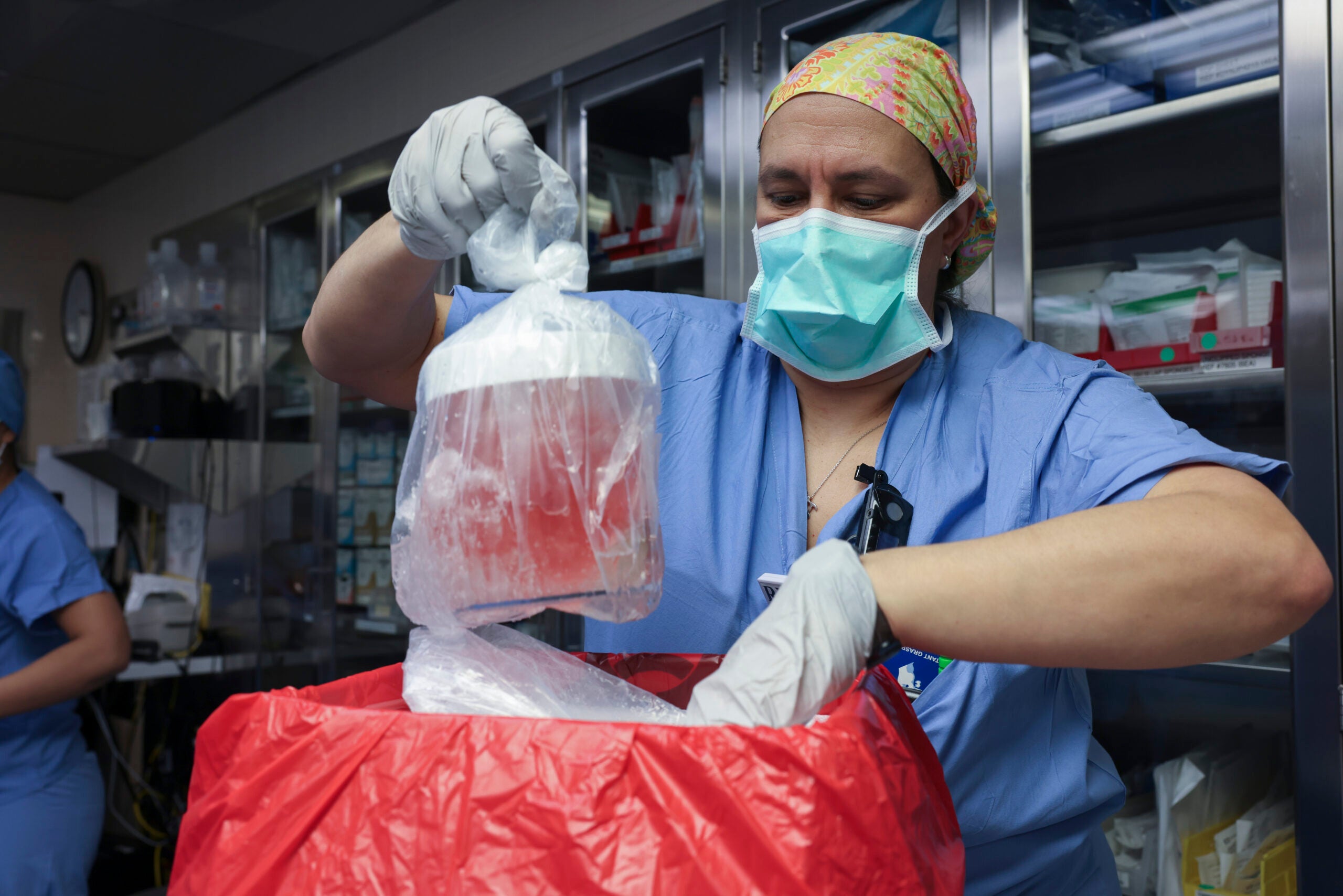Not only can people survive much longer after catastrophic injuries, it’s now possible to revive patients hours after they’ve been pronounced clinically dead.
Sam Parnia, an intensive care physician at the New York University School of Medicine, believes we’re on the cusp of major scientific advances that will transform end-of-life medical care. He’s one of the world’s leading experts in resuscitation medicine and the author of “Lucid Dying.”
Steve Paulson with “To the Best of Our Knowledge” talked recently with Parnia in front of a live audience at the Morgan Library and Museum in New York about the new science of resuscitation medicine.
Stay informed on the latest news
Sign up for WPR’s email newsletter.
This interview has been edited for length and clarity.
Steve Paulson: My sense is that the definition of death has changed quite a bit in recent decades. Wasn’t there a time when it was when the heart stopped? Then it was when the brain stopped functioning. What is the current medical definition of death?
Sam Parnia: Nothing’s changed. The problem is that the concept of a binary separation of life and death is incredibly antiquated.
So how do we define death? Any medical condition, accident or disease that becomes so severe that it causes a person’s heart to stop is death. That’s why the term “cardiac arrest” — which is what we use in hospitals — and “death” are synonymous. It’s the same biological process.
But then what happened in the 1950s and 60s is people who would otherwise have had catastrophic brain injuries were being kept alive on life support machines. And what doctors began to discover is that while they’re on the ventilator, they can have a situation where their brain damage becomes so severe that the brain actually dies. But they’re still on a ventilator, so they look like they’re alive. So it led to a legal notion that you can be declared dead if your brain has died while you happen to be on a ventilator.
Paulson: But you are saying there’s a gray zone when it’s not exactly clear if someone is dead or not. Is it fair to say that death is more of a process than a single moment when someone dies?
Parnia: Yes, sort of. The problem we have is that once you give someone the label of death, it’s supposed to be the end, like there’s no way to move forward.
What happened towards the end of the 1990s and early 2000s was that a revolution started to take place in this field. Scientists were looking for better ways to grow brain cells to deal with diseases like dementia and Parkinson’s and stroke. They started going to mortuaries and they took biopsies of dead people’s brains, and they were able to grow brain cells in a petri dish in the lab.
Over time, that field has grown into what we now call brain organoids. They are growing brains in the lab from cadavers from dead people that are reaching the size of a fetus brain. And it’s fully functional.
Then the other thing that happened, which I can either wait for you to ask me the question or just go ahead and talk about.
Paulson: Are we going to talk about pigs now?
Parnia: We’re going to talk about the pig study.
Paulson: So I’ll introduce this study. A few years ago, a group of scientists went into a slaughterhouse to find decapitated pigs and took away the heads and brought them back to their lab.
Parnia: Even in the early 1980s, it became very clear that scientists could restore activity in cats who had died and had no blood circulation for over an hour. But most people didn’t realize it.
So, fast forward to 2019, when a group of scientists led by Dr. Nenad Sestan from Yale published a study in Nature, which is one of the most prominent scientific journals. What they were able to do is absolutely astonishing. They went to a slaughterhouse, so these were not experimental animals. These were regular animals that were turned into sausage meat, so you can’t be more dead than decapitated dead.
They took these pigs to their own laboratory. They actually called it “a brain in a bucket.” They put the brain in a bucket, connected tubing and put a special solution through the blood vessels and they waited 6 to 10 hours.
So what do we think happened? All of those 32 pig brains came back to life. They restored full activity. There was biological activity, metabolic activity. The blood vessels were responding appropriately.
It was so astonishing that when they showed other scientists those dead brains, they thought they were looking at healthy brains. These scientists were so concerned with the fact that they were restoring life to a dead pig brain that they decided — and this was a concerted effort by the National Institutes of Health, Yale administrators and Dr. Sestan and his colleagues — to significantly downplay their findings.
They said, “Well, we’ve restored metabolic activity, but this brain is not alive.” But this doesn’t make any sense. A brain that has biological activity is alive. They were also so concerned about the possibility of restoring consciousness that they gave sedative drugs to block any signs of consciousness emerging in the brains. And they declared that the brains had not been conscious.
So imagine you’re a pig. Now you wake up and find your brain in a bucket and you’re conscious, but you can’t squeal, you can’t move, you can’t do anything, and you’re trapped.
We have no idea what happened, but the fact is that they did it.
Paulson: And to extrapolate from this study, if you could do that with a pig brain, presumably you could do that with a human brain.
Parnia: That’s exactly right. The technology exists now to do that with the human brain. What they showed is that after we die — for hours of time postmortem — it is possible to restore brain activity.
Of course, the rest of the body is part of that equation, too. So that means we can revive dead people if we are able to move beyond the idea that once we label you dead, it’s the end and you can’t come back again. That is a major discovery that I think will undoubtedly lead to a Nobel Prize.
Paulson: What do these recent discoveries mean for people in hospitals or EMT units? How do you save a person who suddenly has a heart attack? The first thing is to cool the body, right?
Parnia: There’s a lot we can do. Unfortunately, the usual practice across the world is antiquated. People are doing what they did in 1960. So, you do chest compressions, you give oxygen, you may shock the heart, you may give drugs that are very powerful and so on.
But to me, that’s ancient. That’s like driving a Model-T Ford and being happy that you’re driving. It’s ridiculous, frankly. The way I would like to do this is to take people who die and connect them to catheters that will enable us to distribute oxygenated blood nutrients but also a cocktail of drugs like the Yale scientists did that will preserve the brain further and enable us to bring them back to life, assuming that the underlying condition that caused them to die is treatable.
I can’t do this with somebody who’s 90 years old with metastatic cancer, whose body is completely devastated. But if I myself have a heart attack, which I’m at risk of for being a man of my age, I shouldn’t die.
Society thinks death is rapid degradation. Doctors are taught that when you die, you rapidly degrade within five minutes and then you’re gone. But the reality is, it’s just not that way.
You have this long gray zone in which you are truly dead, but your cells go into something like a hibernation state if you know what to do. Now, there is a point in which the damage will lead to degradation. But it is not hours, possibly not even days of time.
We’re making incredible discoveries that will help us not only find how to save people’s lives, but also explore these deep questions as to what happens to all of us when we go through death. So no longer should we think of this as a religious question or a philosophical question. We have science.
This interview was part of our series “Spirituality in the Age of Science,” a collaboration between “To the Best of Our Knowledge” and the Nour Foundation.





